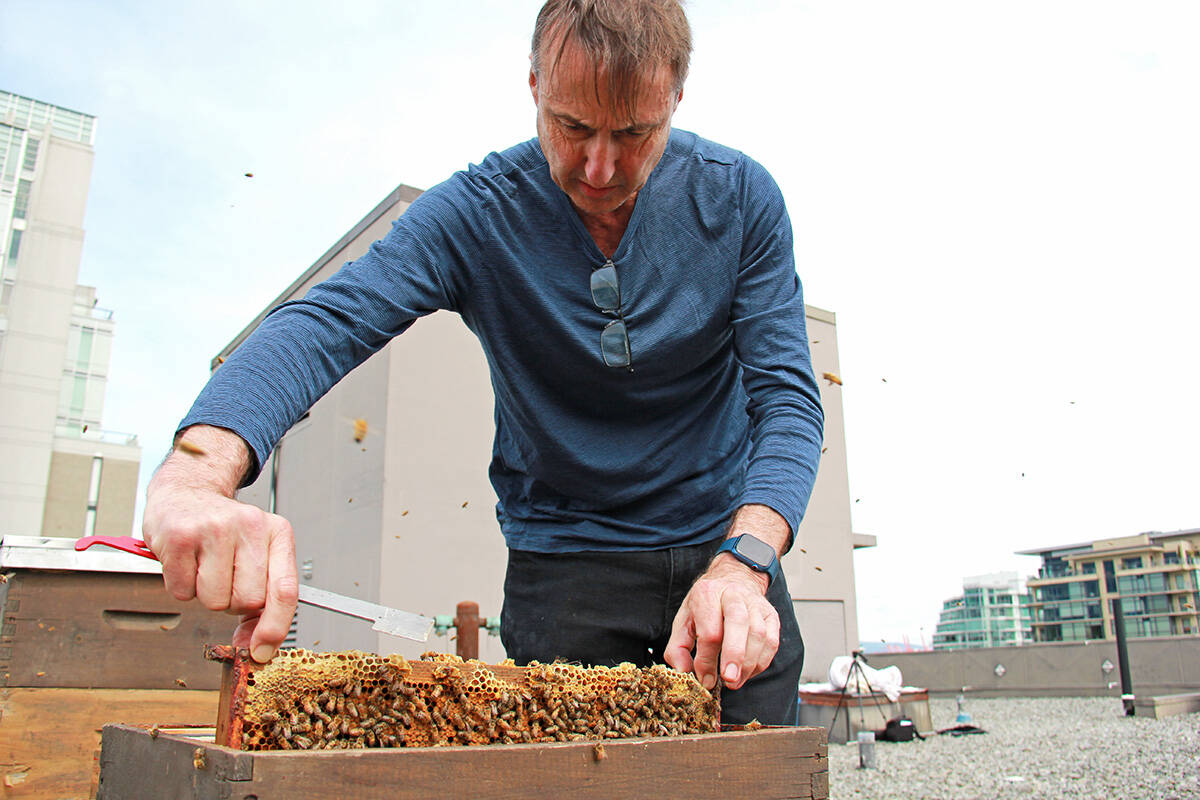Up on the breezy rooftops of seven Vancouver-area apartment buildings, a new effort to strengthen local honey bee populations is emerging.
The creatures buzzing around up there arenB��Ԫ������ַ�t your typical honey bee B��Ԫ������ַ� theyB��Ԫ������ַ�re being specially bred to survive.
B��Ԫ������ַ�Quite simply, not all bees are equal,B��Ԫ������ַ� says the man at the helm of the project, Iain Glass.
HeB��Ԫ������ַ�s works in neuropsychiatry but is also the executive director of not-for-profit Ensure Hive Future, which has spent the last three years creating bee colonies with the most beneficial traits for their microclimate and, perhaps most importantly, with a resistance to the parasite decimating honey bee populations worldwide: the Varroa destructor.
Since the Varroa mite was introduced to North America in the late 1980s, Canada has relied largely on shipments of hundreds of thousands of honey bees from New Zealand a year to replenish dying populations and assist farmers with vital pollination.
The problem with foreign bees, Glass says, is they have no local immunity and no resistance to mites. Emerging out of a package and into a different hemisphere also has its challenges.
B��Ԫ������ַ�They need to adapt to their environment, in terms of the feed, in terms of the temperature, and in terms of the seasons,B��Ԫ������ַ� Glass says.
For him, importing bees is far from a long-term solution. Helping them to adapt and strengthen though, gives Glass hope for the future.
READ ALSO:


Started a year ago, the rooftops are one place where the new honey bees can thrive.
B��Ԫ������ַ�The advantage of rooftops is not only the view for the bees, which they really appreciate B��Ԫ������ַ� just kidding B��Ԫ������ַ� but it keeps the bears away,B��Ԫ������ַ� Glass says, standing atop one such roof in the West End on a warm afternoon in early June.
During this time of the year, Glass or another volunteer checks in on that buildingB��Ԫ������ַ�s two colonies about once a week. On this visit, he gently lifts the lids off each hive as bees transport pollen and nectar through an opening in the side, and inspects the frames of comb.
Each one is at a different level of development, with worker bees just starting their geometric wax designs in some, larvae close to emerging in others, and sticky vats of 35.5-degree honey ready to be harvested in a few.


The honey is one of the reasons Glass says he loves beekeeping. Unbeknownst to most honey consumers, the amber sweetener is as varied in flavour and quality as wine. It all depends on the kinds of flowers honey bees are collecting nectar from.
B��Ԫ������ַ�Quite literally, the honey we produce in the West End will taste a little bit different than the ones we get down near Neptune Terminals versus the ones we get elsewhere in the North Shore,B��Ԫ������ַ� Glass says.
He says they sometimes take colonies to old logging roads on northern Vancouver Island where the bees feast solely on fireweed. The honey produced there is known in the beekeeping world as the B��Ԫ������ַ�champagne of monoflorals,B��Ԫ������ַ� Glass says.
Honeys made in Vancouver, by comparison, rely on countless different flowers and are more of a multi-layer wine.
In a year, Glass says, theyB��Ԫ������ַ�ll harvest between 70 and 100 pounds of honey from each Vancouver colony. TheyB��Ԫ������ַ�re always careful to leave the bees as much as they need first though.
Only in its early stages, Ensure Hive FutureB��Ԫ������ַ�s project to strengthen local bee populations is already gaining international interest. Glass says they recently introduced honey bee colonies to the roof of The Mercer Hotel in New York, and that theyB��Ԫ������ַ�re speaking with people in Australia B��Ԫ������ַ� the only continent free of the Varroa destructor B��Ԫ������ַ� about preventative action.
On a smaller, but nonetheless important, scale Glass encourages people to educate themselves on ways they can support pollinators in their own backyards or balconies. They can find tips and courses on the Ensure Hive Future website at .
READ ALSO:
EditorB��Ԫ������ַ�s note: An earlier version of this story said Glass is a neuropsychologist. He, in fact, works in neuropsychiatry.



jane.skrypnek@bpdigital.ca
Like us on and follow us on .


